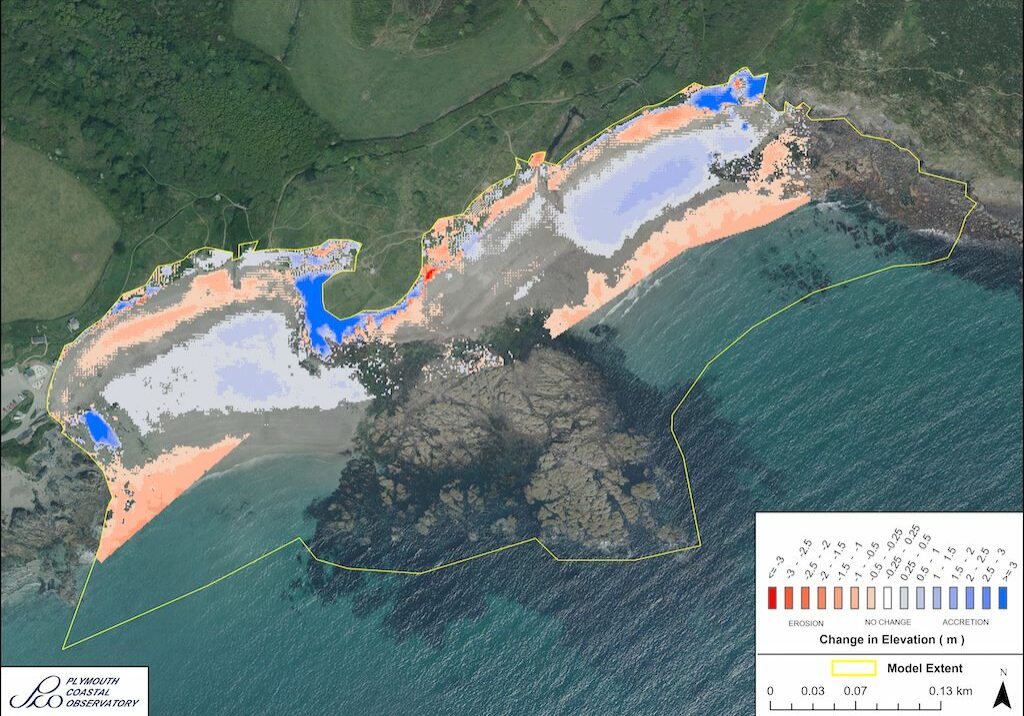
Kennack Sands (Cornish: Porth Kunnyk, meaning ‘Reedbed cove’) is a wide south-east facing beach, on the south coast of Cornwall. Three steep sided wooded valleys converge at Kennack, each of which has a small stream that flows onto the beach.
Kennack Sands is a complicated shaped beach, fringed by steep low cliffs and extensive rocky weathered platforms, most noteworthy are the Caerverracks, which sit in the middle of the beach. The beach is composed of coarser sand and cobble, predominantly composed of locally eroded rock. The uppershore gently climbs to form dunes, with the streams providing areas of wetland. This creates a diverse and rich tapestry of habitats.
Kennack Sands is considered a more rural beach, but its western edge has been developed to accommodate tourism demands. The site is also one with lots of historical features, boasting a peat bed and submarine forest that from time-to-time can become exposed. The site also has a number of Second World War features, from walls, to pillboxes and gun emplacements.


Coastal Change
The coastline of Cornwall is an ever-changing environment. It is energetic, dynamic, never still and changes with each wave and each tidal cycle. Some of the changes we see are gradual and barely noticeable, whilst others, such as rockfalls, happen suddenly and often shockingly.
From one visit to the next it can sometimes be difficult to see how a beach and dune system has changed, but information has been collected, and is being collected through the Making Space for Sand project, to help us better understand how the coastline is changing. The purpose of this section of the website is to understand each location has changed over time, how it could change in the future and understand the policies that influence how we can respond to these changes.
Shoreline Management Plans (SMP)
The Shoreline Management Plan (SMP) is a strategic planning and management assessment tool that helps identify and measure the risk associated coastal erosion and coastal flooding. The document makes a number of policy recommendations over short, medium and long term timeframes setting out a strategic approach to managing the built, natural and historic environments associated with the coastline. Within SMP there are four policy approaches which have been assigned to stretches of coastlines. The four policies are: No Active Intervention (NAI), Hold the Line (HTL), Managed realignment (MR), and Advance the line (ATL).
Kennack Sands sits within Policy Development Zone 6 (PDZ6), in Management Area 15 (MA15), within Policy Unit (PU) 15.5. The policy recommendations for this unit are detailed in the table below and the SMP can be accessed through the Cornwall Council website.
Use your touchscreen
to scroll the below table
| Policy Unit | SMP2 Policy Plan | ||||
| 2025 | 2055 | 2105 | Comment | ||
| 15.1 | Undefended cliffs and coves
Main Policy Sub Policy
|
NAI DnD |
NAI DnD |
NAI DnD |
Allow natural coastal evolution to occur to support conservation interest of protected sites and meet objectives of the Lizard SAC. Monitor risk to historic site at Trebarveth.
|
| 15.5 | Kennack Sands
Main Policy Sub Policy
|
MR LAO |
MR LAO |
MR LAO |
Managed realignment to encourage a natural shoreline with selective maintenance of existing defences to meet local heritage objectives partly relating to archaeological interest on the shoreline. To reflect this, the management approach may be reconsidered to be No Active Intervention - Local Activity Only.
|
| Key: HTL - Hold the Line, A - Advance the Line, NAI – No Active Intervention MR – Managed Realignment
Sub Policy: DnD – Do not Defend, LAO – Local Activity Only |
|||||


National Coastal Erosion Risk Mapping (NCERM)
National Coastal Erosion Risk Mapping (NCERM) provides a baseline of coastal erosion, for the coastline of England, over short, medium and long-term timeframes. The data is based on the natural and defence characteristics of the coastline and provides rates of erosion at differing levels of confidence to help better plan for worse case scenarios. The data provided is for guidance and does not estimate the absolute location of the future coastline.
The basic NCERM lines show erosion estimates for the Short Term (ST-20 years), Medium Term (MT-50 years) and Long Term (LT- 100 years). The data is further categorised by probability: 05 is 5% probability (a 1 in 20 chance of being exceeded) Red Shading, 50 is 50% probability of being exceeded (a 1 in 2 chance of being either exceeded or not exceeded) Orange Shading and 95 is 95% probability (a 19 in 20 chance of being exceeded) Yellow Shading. Click the link below to access the Cornwall Council NCERM Mapping site read the about section then click on layers.
Historical Images of Kennack Sands
Historical photographs provide a powerful insight into how the Cornish coastline has changed within the past Century. The Making Space for Sand project are working in collaboration with the Francis Frith collection and have been given permission to share historical images on a number of beaches considered within the project.
In looking back, we can better understand how the coastline has changed, helping us understand not only how the coastal fringe has developed but also the potential future changes that we my observe. When this is considered alongside forecasts of coastal erosion and sea level rise it will help enable us to better adapt to our changing coastline.
Kennack Sands in 1931 (Image courtesy of the Francis Frith collection) and in 2024.
Kennack Sands from Kennack Towans in1931 (Image courtesy of the Francis Frith collection) and in 2024.

Modelling Coastal Change

Using data that has already been collected, combined with data collected through the Making Space for Sand project, a series of models will be carried out at each location. This will help us better understand how each location may respond to sea level rise and gain a deeper understanding of how coastal sediments move and behave.
The complexity of the modelling, and the data collection that helps inform it, means that modelling outputs will not be the same on all sites. Some locations will be more thoroughly investigated to understand more complex issues and provide data that can be more widely applied to other sites with similar characteristics.
As the project develops this section of the website will expand, sharing new reports and coastal change projections when they are produced.
LiDAR surveys, which are explained on the Data Modelling page, have been carried out by the South West Coastal Monitoring program at this location. The image shared here visualises where sand has eroded (areas shaded in red) and where it has built up (areas shaded in blue), between the LiDAR surveys carried out in 1998 and 2019. The darker the shade of red or blue the greater the amount of sand erosion or accumulation has been observed. The image helps visualise that beaches are areas that change shape over time and will continue to do so as sea levels rise.


Designations
The coastline represents an important transition between the marine environment and the terrestrial environment. This transition creates a range of special habitats and exposes a range of interesting features, which that can result in these spaces being highly designated and protected. There are a range of designations that recognise a variety of different features. At this location these designations are explored below.
Special Area of Conservation (SAC)
A Special Area of Conservation (SAC) is an internationally recognised designation with the aim of protecting habitats or species that are of European importance. Land with SACs is considered to be part of a network of high-quality conservation sites, and those considered to be most in need of conservation at a European level.
Image of a hermit crab (Courtesy of Tony Sutton)
The Lizard SAC and Lizard Point SAC
There are two SAC’s associated with the area, the Lizard SAC that covers on area of approximately 3,083 hectares and the Lizard Point SAC that covers an area of approximately 13,995 hectares.
The Lizard SAC, with its complex geology, is rich in a diversity of cliff vegetation, of particular note are the dry and wet heaths The underlying geology of the area creates calcium deficient and acid rich groundwater bodies and support a unusual range of rare plants.
The Lizard Point SAC is unique in terms of its underlying geology, consisting of rugged inshore and offshore areas of submerged bedrock and boulders, separated by extensive areas of thin, coarse mobile sediment.
Image of an assortment of seaweed (Courtesy of Susan Scott)
Site of Special Scientific Interest (SSSI)
A Site of Special Scientific Interest or SSSI is a statutory conservation designation notified by Natural England denoting protection for biological and/or geological characteristics. The natural wildlife and geological features of SSSI’s are considered to be irreplaceable parts of the national heritage. These are protected in order to preserve their importance, and to prevent damage and development.
The Kennack to Coverack SSSI covers an area of 265.7 hectares. The combination of mild oceanic climate together with the unusual geology, soils and varied topography has led to the development of a range of vegetation types which, in Britain, is unique to the Lizard Peninsula.
Designated Cornwall National Landscape Area
From November 2023, all areas previously know as Areas of Outstanding Natural Beauty, or AONBs, were re-named National Landscape and in Cornwall became Cornwall National Landscape. However, the Management Plan still references the term AONB as this was formally adopted by Cornwall Council and cannot be amended until the next plan is produced.
Cornwall National Landscape areas are protected landscapes whose distinctive character and natural beauty are so outstanding that it is in the nation’s interest to safeguard them. As such they have been nationally designated by the same legislation as National Parks and have the same status and level of protection.
The South Coast Western section covers an area of 19,258 hectares, which is 20% of the Cornwall National Landscape. The key characteristics of this coastal landscape is a soft profile. It benefits from the protection offered by the Penwith peninsula against the full force of the Atlantic storms.
Image of boats in Cadgwith Harbour (Courtesy of Sue Rowlands)
Sign up to Making Space for Sand
If you would like to get involved in helping to make dunes more resilient and biodiverse, want to help develop coastal adaptation and emergency plans or just want to know more about what the project is learning about coastal change, please click here:






